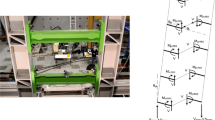Abstract
This study focuses on multi-objective performance-based seismic optimization of steel moment frames by an efficient algorithm. In the present study, an efficient framework is developed to find a Pareto front for multi-objective optimization problem of steel moment frames involving global damage index and initial cost as two conflicting objective functions. To this end, a new multi-objective algorithm is introduced and its efficiency is demonstrated trough a set of benchmark multi-objective truss design examples. Subsequently, a 6- and a 12-story steel moment frame are designed by the proposed algorithm. To evaluate the seismic performance and collapse capacity of the optimal designs, damage indices and incremental dynamic analysis are used and their seismic damage costs and adjusted collapse margin ratios are evaluated.


















Similar content being viewed by others
References
Gandomi AH, Yang XS, Talatahari S, Alavi AH (2013) Metaheuristic applications in structures and infrastructures. Elsevier, London
Gholizadeh S (2015) Performance-based optimum seismic design of steel structures by a modified firefly algorithm and a new neural network. Adv Eng Softw 81:50–65. https://doi.org/10.1016/j.advengsoft.2014.11.003
Kaveh A, Nasrollahi A (2014) Performance-based seismic design of steel frames utilizing charged system search optimization. Appl Soft Comput 22:213–221. https://doi.org/10.1016/j.asoc.2014.05.012
Kaveh A, Farahmand Azar B, Hadidi A, Rezazadeh Sorochi F, Talatahari S (2014) Performance-based seismic design of steel frames using ant colony optimization. J Constr Steel Res 66:566–574. https://doi.org/10.1016/j.jcsr.2009.11.006
Fragiadakis M, Lagaros ND, Papadrakakis M (2006) Performance-based multiobjective optimum design of steel structures considering life-cycle cost. Struct Multidisc Optim 32:1–11. https://doi.org/10.1007/s00158-006-0009-y
Kaveh A, Kalateh-Ahani M, Fahimi-Farzam M (2014) Damage-based optimization of large-scale steel structures. Earthq Struct 7:1119–1139. https://doi.org/10.12989/eas.2014.7.6.1119
Vamvatsikos D, Cornell CA (2002) Incremental dynamic analysis. Earthq Eng Struct Dyn 31(3):491–514. https://doi.org/10.1002/eqe.141
Ibarra LF, Krawinkler H (2005) Global collapse of frame structures under seismic excitations. Berkeley: Report No. PEER 2005/06, Pacific Earthquake Engineering Research Center
Haselton CB, Baker JW, Liel AB, Deierlein GG (2011) Accounting for ground motion spectral shape characteristics in structural collapse assessment through an adjustment for epsilon. J Struct Eng 137(3):332–344. https://doi.org/10.1061/(ASCE)ST.1943-541X.0000103
Haselton CB, Liel AB, Deierlein GG, Dean BS, Chou JH (2011) Seismic collapse safety of reinforced concrete buildings: I. Assessment of ductile moment frames. J Struct Eng 137(4):481–491. https://doi.org/10.1061/(asce)st.1943-541x.0000318
FEMA-P695 (2009) Quantification of building seismic performance factors. Federal Emergency Management Agency, Washington
Asgarian B, Sadrinezhad A, Alanjari P (2010) Seismic performance evaluation of steel moment resisting frames through incremental dynamic analysis. J Constr Steel Res 66:178–190. https://doi.org/10.1016/j.jcsr.2009.09.001
Fattahi F, Gholizadeh S (2019) Seismic fragility assessment of optimally designed steel moment frames. Eng Struct 179:37–51. https://doi.org/10.1016/j.engstruct.2018.10.075
HAZUS-MH MR1 (2003) Multi-hazard loss estimation methodology earthquake model. FEMA-National Institute of Building Sciences, Washington
Kang YJ, Wen YK (2000) Minimum life-cycle cost structural design against natural hazards Tech. Rep. SRS 629. University of Illinois at Urbana-Champaign
Park YJ, Ang AH-S (1985) Mechanistic seismic damage model for reinforced concrete. ASCE J Struct Eng 111:722–739. https://doi.org/10.1061/(ASCE)0733-9445(1985)111:4(722)
Coello CAC, Pulido GT, Lechuga MS (2004) Handling multiple objectives with particle swarm optimization. IEEE Trans Evol Comput 8:256–279. https://doi.org/10.1109/TEVC.2004.826067
Knowles JD, Corne DW (2000) Approximating the nondominated front using the Pareto archived evolution strategy. Evol Comput 8:149–172. https://doi.org/10.1162/106365600568167
Deb K, Pratap A, Agarwal S, Meyarivan T (2002) A fast and elitist multi objective genetic algorithm: NSGA-II. IEEE Trans Evol Comput 6:182–197. https://doi.org/10.1109/4235.996017
Tejani GG, Kumar S, Gandomi AH (2018) Multi-objective heat transfer search algorithm for truss optimization. Eng Comput. https://doi.org/10.1007/s00366-019-00846-6
Saadat S, Camp CV, Pezeshk S (2014) Seismic performance-based design optimization considering direct economic loss and direct social loss. Eng Struct 76:193–201. https://doi.org/10.1016/j.engstruct.2014.07.008
Choi SW, Park HS (2012) Multi-objective seismic design method for ensuring beam hinging mechanism in steel frames. J Constr Steel Res 74:17–25. https://doi.org/10.1016/j.jcsr.2012.01.012
Mokarram V, Banan MR (2018) An improved multi-objective optimization approach for performance-based design of structures using nonlinear time-history analyses. Appl Soft Comput 73:647–665. https://doi.org/10.1016/j.asoc.2018.08.048
Xu J, Spencer BF, Lu X (2017) Performance-based optimization of nonlinear structures subject to stochastic dynamic loading. Eng Struct 134:334–345. https://doi.org/10.1016/j.engstruct.2016.12.051
Gholizadeh S, Baghchevan A (2017) Multi-objective seismic design optimization of steel frames by a chaotic meta-heuristic algorithm. Eng Comput 33:1045–1060. https://doi.org/10.1007/s00366-017-0515-0
Kaveh A, Laknejadi K, Alinejad B (2012) Performance-based multi-objective optimization of large steel structures. Acta Mech 223:355–369. https://doi.org/10.1007/s00707-011-0564-1
Kaveh A, Kalateh-Ahani M, Fahimi-Farzam M (2014) Life-cycle cost optimization of steel moment-frame structures: performance-based seismic design approach. Earthq Struct 7:271–294. https://doi.org/10.12989/eas.2014.7.3.271
Kaveh A, Fahimi-Farzam M, Kalateh-Ahani M (2015) Performance-based multi-objective optimal design of steel frame structures: nonlinear dynamic procedure. Sci Iran A 22:373–387
Kaveh A, Fahimi-Farzam M, Kalateh-Ahani M (2015) Optimum design of steel frame structures considering construction cost and seismic damage. Smart Struct Syst 16:1–26. https://doi.org/10.12989/sss.2015.16.1.001
FEMA-350 (2000) Recommended seismic design criteria for new steel moment-frame buildings. Federal Emergency Management Agency, Washington
Park YJ, Ang AH, Wen YK (1987) Damage-limiting aseismic design of buildings. Earthq Spectra 3:1–26. https://doi.org/10.1193/1.1585416
Kunnath SK, Reinhorn AM, Lobo RF (1992) IDARC version 3.0: a program for the inelastic damage analysis of reinforced concrete structures. Technical report NCEER-92-0022. National Center for Earthquake Engineering Research, Buffalo, NY
Ghosh S, Datta D, Katakdhond AA (2011) Estimation of the Park-Ang damage index for planar multi-storey frames using equivalent single-degree systems. Eng Struct 33:2509–2524. https://doi.org/10.1016/j.engstruct.2011.04.023
Mekki M, Elachachi SM, Breysse D, Zoutat M (2016) Seismic behavior of R.C. structures including soil-structure interaction and soil variability effects. Eng Struct 126:15–26. https://doi.org/10.1016/j.engstruct.2016.07.034
AISC 360-16 (2016) Specification for structural steel buildings. American Institute of Steel Construction, Chicago
Gholizadeh S, Fattahi F (2012) Design optimization of tall steel buildings by a modified particle swarm algorithm. Struct Design Tall Spec Build 23:285–301. https://doi.org/10.1002/tal.1042
AISC 341-16 (2016) Seismic provisions for structural steel buildings. American Institute of Steel Construction, Chicago
OpenSees version 2.4.0 [Computer software]. PEER, Berkeley, CA
Author information
Authors and Affiliations
Corresponding author
Additional information
Publisher's Note
Springer Nature remains neutral with regard to jurisdictional claims in published maps and institutional affiliations.
Rights and permissions
About this article
Cite this article
Gholizadeh, S., Fattahi, F. Multi-objective design optimization of steel moment frames considering seismic collapse safety. Engineering with Computers 37, 1315–1328 (2021). https://doi.org/10.1007/s00366-019-00886-y
Received:
Accepted:
Published:
Issue Date:
DOI: https://doi.org/10.1007/s00366-019-00886-y




